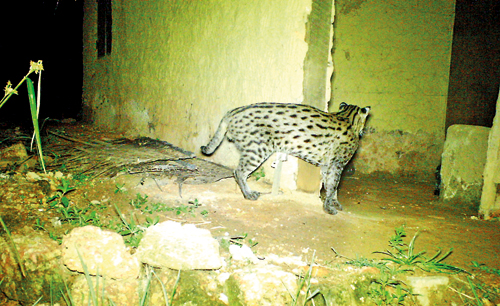Our small cats are precious wildlife too

Night visitor: A fishing cat on the prowl. Pic courtesy ‘Urban Fishing Cat Conservative Project’
Driving on the Japan Sri Lanka Friendship Road, you’d never think that an elusive wild animal may cross these paths. While many of us travel to Yala and other places to see leopards, we are unaware that a rare and elusive species of wild cat may be roaming our backyards. Researchers Anya Ratnayaka and Ashan Thudugala are working tirelessly to get the small wild cat species they are researching – the fishing cat, rusty-spotted cat, and the jungle cat the recognition they deserve, through SCAR (Small Cat Advocacy and Research), the organisation they set up in 2017.
Of the 41 species of wild cats in the world, 33 of them are small wild cats. Small wild cats are alarmingly threatened with extinction by a variety of different factors like habitat destruction, hunting, urbanisation and conflict with humans amongst others. Among the small wild cat species around the world are the African golden cat, Andean mountain cat, Black-footed cat, Fishing cat and the Northern tiger cat.
Last month from the 7th to the 11th, 32 researchers from 15 countries gathered in Colombo for the second Small Wild Cat Conservation Summit (SWCCS). Coming from Uganda, South Africa, Nepal, India, Bangladesh, Sri Lanka, Bhutan, Cambodia, Japan, Mongolia, Iran, UAE, Chile, Peru and the USA they shared experiences at the summit organised by the Small Wild Cat Conservation Foundation with SCAR as the local organisers. The first summit was held in Kent, England in 2017.
Each participant spoke about their research and experience in working with small wild cats. Essentially it became a knowledge sharing platform. “By doing this, we plan to propose more conservation and communication between the people who are doing actual conservation in the field, share our thoughts and help them in their work,” Ashan explains. In ‘The future is not golden: Conflict with local communities and poaching threaten African golden cats in Uganda’ Badru Mugerwa spoke about the unlikely viewpoint of the poachers, and how addressing them is an important factor that is often overlooked. Badru did his research in ‘ Investigating the effects of anthropogenic disturbance: extirpation of a large carnivore, poaching of wildlife and human presence on the behaviour of tropical forest mammals’ for his Masters in Biology at the University of Western Ontario.

Ashan Thudugala
American conservationist Laurel Serieys took the floor to talk about ‘People, poisons, and properties: Generating conservation outcomes from small cat research’. Her eye-opening talk was on bobcats in the Los Angeles area where she addressed how research can be translated into policy change. Laurel’s PhD research at the University of California, Los Angeles graduate program in Ecology and Evolutionary Biology focused on how urbanisation and pesticides drive genetic change and disease susceptibility in urban bobcats. In an optional workshop at the summit titled, ‘Capturing, collaring and collecting biological material from small wild cats’, she handled the practical side of collaring small wild cats. She also passed on this information to Anya which, Anya says has aided her greatly in capturing the wild cats.
Ashan’s involvement started with the ‘Save Fishing Cat Conservation Project (SFCCP)’ in 2013 and his strong ambition of reducing fishing cat threats through community based conservation. SFCCP works closely with local communities to resolve human – wild cat conflicts. Some of their actions have been erecting road signs and information boards in crucial road kill areas, building enclosures for injured small wild cats, and conducting workshops and awareness programmes for schoolchildren as well as hosting an annual Fishing Cat Youth Camp Training Programme. They also hope to develop rehabilitation centres for these cat species.

Anya Ratnayaka
In his talk ‘Small wild cat conservation in the Central Hills, Sri Lanka’, Ashan spoke about his own experience of working with small wild cats and the building of wildlife enclosures and rehabilitation centres with the Wild Life Department. “This initiative initially started in 2006 and was led by Dr Eric Wikramanayake and his team, who wanted to confirm the fishing cat presence in urban areas. They set camera traps and they confirmed it, but they had to stop because of the war,” Anya explains.
Anya’s passion for small cats was sparked following a chance encounter with a fishing cat when she had returned to Sri Lanka after obtaining a degree in Wildlife and Conservation Management from the University of Queensland in Australia. A Global Wildlife Conservation Associate Conservation Scientist since 2017, Anya in her presentation titled, ‘Conserving fishing cats as a flagship species for urban wetland conservation’, spoke about how she set out to find the cats, and how she got footage of a male fishing cat eating fish in a pond in a Colombo residence.Speaking of her Urban Fishing Cat Conservation Project, she had the audience fascinated when she highlighted maps of Colombo and areas where the fishing cats travelled through, roads such as the Japan Sri Lanka Friendship Road.
“It’s been really amazing to work with Anya – I’ve been learning a lot from her about the community here and the role that the fishing cats play in the wetlands and for me it’s a really unique experience because we don’t really have wetlands species in the other places that I’ve worked. I’m just in awe of the fishing cats and how tolerant they are of urbanization. And how adaptable,” Laurel says.
“I think that they are able to survive in more urbanized areas than the bobcats and caracals that I have worked with. My hypothesis is that it’s because they are able to feed on koi fish or rats that are in the city. The presence of prey tends to determine the presence of the predators so I think that they are able to find prey in a way in which bobcats and caracals can’t find prey,” she says.
“It’s all about marketing, that’s why awareness is so important because you can’t protect a species any more on pure research. I think we have come to a point on this planet of ours where we need to start getting people to care, and not just the scientists,” Anya states. Laurenl echoes her view, stressing that writing about the issue in a way that people can understand is crucial, so the research has far-reaching effects.
A key message that Anya and Ashan want to carry to the general public is that if people have a pet cat, they need to get it vaccinated as airborne viruses such as Feline Parvo and Feline Leukemia spread from domestic cats to small wild cats. Anya recounts seeing a fishing cat at a rehab centre and then seeing it die a few hours later from Feline Parvo.
Follow Anya’s project on: https://instagram.com/urbanfishingcat?igshid=12bp6p5cftfzzand Ashan’s on: https://instagram.com/savefishingcat?igshid=1iul4gzptouif.
| Facts about the Fishing Cat | |
| Adapted to a semi-aquatic lifestyle, the urban fishing cat Prionailurus viverrinus is known in Sinhala as Handun Diviya and in Tamil as Koddi Poonai. The fishing cat has now become the flagship species for urban wetland conservation in Colombo. Weighing between 8 to 16kg, with a beautiful olive grey and brown tinged coat patterned with rows of parallel solid black spots along its flank, the cats live among us even though rarely seen. While many think that the fishing cat can harm people, biting is actually their last resort. Fishing cats are shy which is why we don’t see them very often. |
| Small Cat Advocacy and Research (SCAR) | |
| Anya and Ashan started Small Cat Advocacy and Research (SCAR) in 2017 with the country’s three small cat species—fishing cat, rusty-spotted cat, and the jungle cat in mind. “We want to promote young biologists to start working on our own wildlife because we have so much to offer in this country. There are so many species that are so poorly understood and studied that it’s time we started protecting and learning about them. Rather than going and working on big international lion or leopard projects, we started SCAR so that local biologists have a home base to study our own wildlife,” Anya says. People can use an affiliation with SCAR to apply for grants. SCAR vets the proposal and does not invoice any administration costs for this process. Visit https://save.cat/to report small cat sightings and help Anya and Ashan with their research on the distribution of small wild cats as well as the hot spot areas of human-small wild cat conflict. Anyone interested in becoming a SCAR conservationist, visit https://scar.lk/work-with-us/. |


